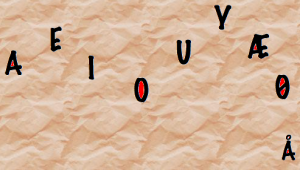Danish Vowels: A, E, I Posted by Bjørn A. Bojesen on Aug 29, 2012 in Uncategorized
Language geeks love Danish. They’re amazed by the fact that the language is full of strange vowel sounds, and that we Danes pronounce our consonants with so much ”timidity” that the whole language sounds like a stream of vowels (our a soup, if you like 🙂 ). Yeah, if you analyze it at scientific level, there really are many vowel shades in Danish (according to phonetician Ruben Schachtenhaufen, the count ranges between 10 and 50!) Fortunately, you don’t have to be a scientist to learn Danish! Many people have learnt perfect communicational Danish even if they didn’t get every a or e ”natively correct”.
There are 9 basic vowels in Danish. Each of them can be either short or long, and it can be pronounced with or without stød. A stød is a kind of cough pronounced at the same time as the vowel (let’s review this one later!)
The basic vokaler [voKAHLor] (vowels) are: A, E, I, O, U, Y, Æ, Ø, Å.
Let’s take a look at the three first ones:
A In most words, A sounds a lot like the light a of English cat: kat (cat), vane (habit). This is the common way of saying A in Danish. Use it whenever you’re in doubt. Next to R, however – or when it’s short and stands in front of F, P, K or M – it usually sounds like the dark a of English father: rasende [RAHsehneh] (furious), bar (bar), kaffe (coffee), snaps (schnapps), tak (thanks), ham (him). Once again – the A’s of the last four examples are all short. In a word like dame (lady) [DAAmeh], it’s long and has the normal, light pronunciation.
E The long E has a very tight pronunciation. Many foreigners confuse it with an I [as in ”feet”]: en (one, sounds almost like ”in”), ledig [LEH-thee] (free, unoccupied). The short E is more open, like the e of English bet: hest (horse), let (light, easy). In unstressed syllables it sounds like the muffled e of English the bat: bakke [BAHkeh] (hill). In partnership with an R, this unstressed E makes a British ”or” kind of sound: biler [BEELoʳ] (cars), bedre [BETHRoʳ] (better).
I The I usually sounds like the I’s of other languages (somewhere in the range of English bit and beat): is [ees] (ice, ice-cream), lille [LILLeh] (little, small). When it’s short, though, it occasionally sounds a wee bit more open, just like a short version of the long E: lidt (a little bit, almost sounds like ”let”), Mikkel (Michael).
Okay, that wasn’t that hard, was it? Now, listen to some Danish music and relax. Tomorrow we’ll take a look at the remaining little bastards…

Build vocabulary, practice pronunciation, and more with Transparent Language Online. Available anytime, anywhere, on any device.
About the Author: Bjørn A. Bojesen
I was born in Denmark, but spent large parts of my childhood and study years in Norway. I later returned to Denmark, where I finished my MA in Scandinavian Studies. Having relatives in Sweden as well, I feel very Scandinavian! I enjoy reading and travelling, and sharing stories with you! You’re always welcome to share your thoughts with me and the other readers.





Comments:
Gilda:
THIS IS EXACTLY what I was needing!
Tusind mange gange tak 🙂
Liam:
Hey Bjørn,
Jeg kommer fra England og er super glad for din blog! Tak for hjælpen!
Bjørn A. Bojesen:
@Liam Hej Liam,
mange tak for din feedback! Held og lykke med det danske sprog. 🙂